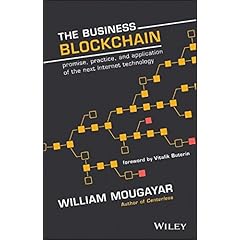 |
| Amazon link |
Bitcoin emerged on the scene in 2009, the first digital currency to achieve lift-off. Satoshi Nakamoto's brilliant innovation was to make the transaction the central concept. The Blockchain is a complete record of every Bitcoin transaction ever carried out. The wallet containing ‘your Bitcoins’ is a secondary construct, computed from scanning the public Blockchain on the Internet and adding up all the ‘unspent transaction outputs’ which have one of your Bitcoin addresses as a recipient.
The Blockchain is public, duplicated on all full Bitcoin nodes (i.e. computers), and the transactions, organised in blocks, are unencrypted. Yet transactions are still sufficiently secure and anonymous – the architecture and protocol design to accomplish this is both complex and amazing. It soon occurred to people that the Blockchain concept could be repurposed to support other services across the public Internet: the management of contracts, the administration of digital identity, healthcare records.
Just as the public Internet spawned private Intranets and business-ecosystem Extranets, Blockchain technology has begun to interest companies looking to exploit a robust, decentralised ‘smart database’ function internally, or with their customers/suppliers. We are in the earliest days of this new network technology and many, even basic, questions of architecture, design, implementation and operation are deeply unclear. It’s timely then, to have a book explaining the ‘Business Blockchain’.
Chapter 1 of William Mougayar’s book aims to explain what the Blockchain is all about. He uses a great many metaphors intermixed with appropriate tech buzz-words, but I don’t think the reader will be much the wiser after reading it. Saying endlessly that the Blockchain is like a decentralised database, like a shared accounting ledger, like a transaction platform, it’s a peer-to-peer network and a trust services layer is all sort of true, but leaves the reader ignorant as to how the Blockchain manages to accomplish all these marvels. It was at this point, I decided to read Andreas M. Antonopoulos's excellent “Mastering Bitcoin: Unlocking Digital Cryptocurrencies” which made everything a lot clearer (the book is accessible to non-developers).
Chapter 2 focuses on the Blockchain’s role in distributing trust. In Bitcoin, trust is about ensuring that someone who pays you has a right to the Bitcoin they’re sending you, and that they can’t spend that amount twice. There are specific mechanisms involving digital certificates and the Blockchain mining protocols (producing ‘confirmations’) which implement the trust relationship. The author doesn’t engage with these issues, however. Instead we get lots of cotton wool marketing speak, essentially hand-wavy boosterism for how wonderful the Blockchain model is, leading to further and rather vague excitement about Ethereum-style smart contracts (no details). The ratio of useful-ideas to words-expended is particularly low in this chapter.
Chapter 3 is a simple ‘innovator’s dilemma’ style essay on Blockchain acceptance. We are in the earliest stages of take-up, mostly because Blockchain architectures and implementations are very new and there are plainly many issues in adapting these ideas to other application areas, and up-scaling the platforms. This is entirely normal – most new technologies go through a phase where the technical guys have to link up with the business strategy guys to research possible new solutions. I think I just summarised that chapter.
Chapter 4 is entitled, ‘Blockchain in Financial Services’ and starts with an overview of the Banking and Financial Services industries’ responses to the Internet (less than impressive). There then follows a list of financial services where you could imagine Blockchain technologies having an impact with a few summary examples of exploratory prototypes. Regulation is correctly identified as a major constraint for Blockchain-type architectures. The chapter ends with a little more boosterism, although the truth is that all major financial institutions have already set up task forces to research this area. As before, there is no real content to this chapter.
The short chapter 5 looks at some more far-out examples of Blockchain-powered applications, specifically the ‘Distributed Autonomous Organisation’ (DAO) based on smart contracts and pioneered by Ethereum: again, very hand-wavy and speculative, with no depth.
Chapter 6, ‘Implementing Blockchain technology’, advises your organisation to appoint a “Blockchain Czar” to get things moving, and then lists all the requirements for a successful software project - which would apply to any new development programme: statements of the blindingly obvious, really.
The final chapter, ‘Decentralization as the way forward’, is an unashamedly utopian vision of 2025, when Blockchain-powered, decentralised crypto-services will have transformed the world.
No they won’t.
In summary, this book is superficial boosterism expressed in crass marketing-speak. The reader, far from being enlightened, will end up more confused than ever. My advice is to find a text which explains – in conceptual outline – how the Blockchain (and its main application, Bitcoin) actually works (Wikipedia is not bad). You will then be in a position to assess whether this model has any application for your business. Unless you are a disruptive, entrepreneurial innovator or a company operating in a specialist niche, you will probably correctly conclude that it is too early to tell. Ask the strategy guys to keep an eye on it. And save your money on this book.
I can set up my new idea from this post. It gives in depth information. Thanks for this valuable information for all,..
ReplyDeleteico